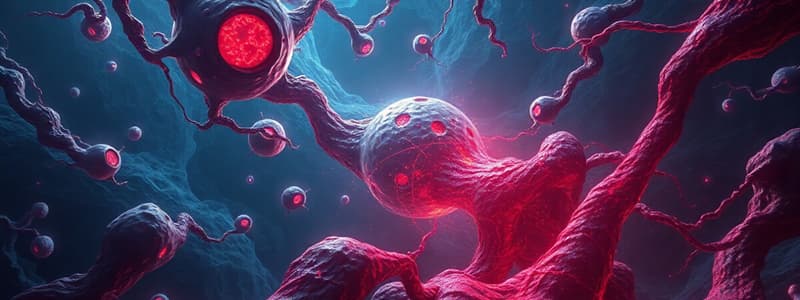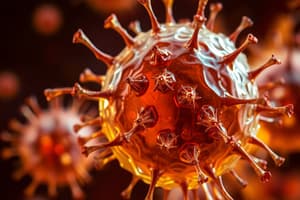Podcast
Questions and Answers
What is the primary characteristic of necrosis compared to apoptosis?
What is the primary characteristic of necrosis compared to apoptosis?
- Necrosis causes inflammation and affects surrounding areas. (correct)
- Necrosis involves a programmed death process.
- Necrosis is always beneficial for cellular maintenance.
- Necrosis occurs only when cells are instructed to die.
Which protein plays a crucial role in activating the intrinsic pathway of apoptosis?
Which protein plays a crucial role in activating the intrinsic pathway of apoptosis?
- Fas ligand
- BH3-only proteins (correct)
- BAX
- BCL2
What initiates the extrinsic pathway of apoptosis?
What initiates the extrinsic pathway of apoptosis?
- Leakage of cytochrome C from mitochondria
- DNA damage within the cell
- Internal cellular stress signals
- Binding of death ligands to death receptors (correct)
The activation of which proteins leads to the release of cytochrome C in the intrinsic pathway?
The activation of which proteins leads to the release of cytochrome C in the intrinsic pathway?
What is the effect of anti-apoptotic proteins like BCL2 in the intrinsic pathway?
What is the effect of anti-apoptotic proteins like BCL2 in the intrinsic pathway?
Which of the following is NOT a trigger for the intrinsic pathway of apoptosis?
Which of the following is NOT a trigger for the intrinsic pathway of apoptosis?
What role do initiator caspases play in the apoptosis process?
What role do initiator caspases play in the apoptosis process?
Which of the following correctly describes the role of CD8 T-cells in apoptosis?
Which of the following correctly describes the role of CD8 T-cells in apoptosis?
What initiates the formation of the Death Inducing Signalling Complex (DISC) in the extrinsic pathway of apoptosis?
What initiates the formation of the Death Inducing Signalling Complex (DISC) in the extrinsic pathway of apoptosis?
Which pathway is directly influenced by the activation of executioner caspases 3, 6, and 7?
Which pathway is directly influenced by the activation of executioner caspases 3, 6, and 7?
How does granzyme B contribute to the activation of the intrinsic apoptotic pathway?
How does granzyme B contribute to the activation of the intrinsic apoptotic pathway?
What is the role of cytotoxic T cells in the apoptosis process?
What is the role of cytotoxic T cells in the apoptosis process?
Which feature is NOT associated with the processes carried out by activated executioner caspases during apoptosis?
Which feature is NOT associated with the processes carried out by activated executioner caspases during apoptosis?
In the intrinsic pathway, what triggers the release of cytochrome C from the mitochondria?
In the intrinsic pathway, what triggers the release of cytochrome C from the mitochondria?
What is the primary change in cells that undergo hypertrophy due to stress?
What is the primary change in cells that undergo hypertrophy due to stress?
Which process is inhibited during apoptosis to prevent uncontrolled cell growth?
Which process is inhibited during apoptosis to prevent uncontrolled cell growth?
What is the role of Cytochrome C in the intrinsic pathway of apoptosis?
What is the role of Cytochrome C in the intrinsic pathway of apoptosis?
Which of the following correctly describes the role of caspase 9?
Which of the following correctly describes the role of caspase 9?
What initiates apoptosis in the extrinsic pathway?
What initiates apoptosis in the extrinsic pathway?
What role does FADD play in the apoptosis process?
What role does FADD play in the apoptosis process?
Which of the following is NOT a method by which executioner caspases induce apoptosis?
Which of the following is NOT a method by which executioner caspases induce apoptosis?
What is the function of CD 8 T-cells in the apoptosis process?
What is the function of CD 8 T-cells in the apoptosis process?
During apoptosis, which of the following events occurs last in the intrinsic pathway?
During apoptosis, which of the following events occurs last in the intrinsic pathway?
Which statement about death ligands and their receptors is accurate?
Which statement about death ligands and their receptors is accurate?
Which mechanism of cell death is characterized by inflammation and uncontrolled cell destruction?
Which mechanism of cell death is characterized by inflammation and uncontrolled cell destruction?
Which pathway is primarily regulated by internal stress signals like DNA damage?
Which pathway is primarily regulated by internal stress signals like DNA damage?
What is the role of BH3-only proteins in the intrinsic pathway of apoptosis?
What is the role of BH3-only proteins in the intrinsic pathway of apoptosis?
What is the primary consequence of the activation of pro-apoptotic proteins in the intrinsic pathway?
What is the primary consequence of the activation of pro-apoptotic proteins in the intrinsic pathway?
Which of the following is a key characteristic distinguishing apoptosis from necrosis?
Which of the following is a key characteristic distinguishing apoptosis from necrosis?
In the extrinsic pathway of apoptosis, what initiates the signaling cascade leading to cell death?
In the extrinsic pathway of apoptosis, what initiates the signaling cascade leading to cell death?
Which of the following proteins is inhibited by BH3-only proteins during the intrinsic pathway?
Which of the following proteins is inhibited by BH3-only proteins during the intrinsic pathway?
What triggers the release of cytochrome C into the cytoplasm during apoptosis?
What triggers the release of cytochrome C into the cytoplasm during apoptosis?
Which type of cell death is best described as a controlled process crucial for normal development?
Which type of cell death is best described as a controlled process crucial for normal development?
What is the main role of executioner caspases in apoptosis?
What is the main role of executioner caspases in apoptosis?
What is the best description of cellular adaptation?
What is the best description of cellular adaptation?
Which type of cellular response involves an increase in cell size?
Which type of cellular response involves an increase in cell size?
What happens during reversible injury to a cell?
What happens during reversible injury to a cell?
What is a likely outcome of prolonged or intense cellular stress?
What is a likely outcome of prolonged or intense cellular stress?
What is metaplasia in cellular response to stress?
What is metaplasia in cellular response to stress?
Which of the following factors does NOT significantly influence a cell's response to stress?
Which of the following factors does NOT significantly influence a cell's response to stress?
In the context of cellular stress responses, what does atrophy indicate?
In the context of cellular stress responses, what does atrophy indicate?
What is a characteristic of irreversible injury in cells?
What is a characteristic of irreversible injury in cells?
How does adaptation help cells cope with low oxygen levels?
How does adaptation help cells cope with low oxygen levels?
What is a common adaptive response to high toxic exposure?
What is a common adaptive response to high toxic exposure?
What occurs after caspase-8 is activated in the apoptosis process?
What occurs after caspase-8 is activated in the apoptosis process?
How do cytotoxic T cells trigger apoptosis in target cells?
How do cytotoxic T cells trigger apoptosis in target cells?
What is the role of granzyme B in the apoptosis process?
What is the role of granzyme B in the apoptosis process?
What eventually results from the activation of executioner caspases in apoptosis?
What eventually results from the activation of executioner caspases in apoptosis?
What type of cellular adaptive response involves an increase in cell size?
What type of cellular adaptive response involves an increase in cell size?
What is the role of BH3-only proteins in the apoptosis pathway?
What is the role of BH3-only proteins in the apoptosis pathway?
Which feature is characteristic of apoptosis as a mechanism of cell death?
Which feature is characteristic of apoptosis as a mechanism of cell death?
What is a consequence of pro-caspase cleavage during the apoptosis process?
What is a consequence of pro-caspase cleavage during the apoptosis process?
Which statement accurately describes the intrinsic apoptosis pathway?
Which statement accurately describes the intrinsic apoptosis pathway?
What is the primary function of the Death Inducing Signalling Complex (DISC) in apoptosis?
What is the primary function of the Death Inducing Signalling Complex (DISC) in apoptosis?
What is the first step that occurs when cytochrome C leaks into the cytoplasm?
What is the first step that occurs when cytochrome C leaks into the cytoplasm?
Which molecule is activated by the binding of caspase 9 with executioner caspases?
Which molecule is activated by the binding of caspase 9 with executioner caspases?
What role do executioner caspases play in the apoptosis process?
What role do executioner caspases play in the apoptosis process?
Which of the following statements about the binding of FAS ligands and receptors is correct?
Which of the following statements about the binding of FAS ligands and receptors is correct?
What is the primary function of FADD in the apoptosis pathway?
What is the primary function of FADD in the apoptosis pathway?
Which type of apoptosis pathway is described as originating from outside the cell?
Which type of apoptosis pathway is described as originating from outside the cell?
During the extrinsic pathway, what is the effect of death ligands binding to their receptors?
During the extrinsic pathway, what is the effect of death ligands binding to their receptors?
Which of the following does NOT occur as a method of apoptosis by executioner caspases?
Which of the following does NOT occur as a method of apoptosis by executioner caspases?
Which role do cytotoxic CD 8 T-cells serve in apoptosis?
Which role do cytotoxic CD 8 T-cells serve in apoptosis?
What outcome results from the aggregation of death receptors in the extrinsic apoptosis pathway?
What outcome results from the aggregation of death receptors in the extrinsic apoptosis pathway?
Flashcards are hidden until you start studying
Study Notes
Apoptosis
- Apoptosis is a process of programmed cell death that is essential for normal development, tissue homeostasis, and the elimination of damaged or unwanted cells.
- It is a highly regulated process that eliminates cells in a controlled manner, minimizing damage to surrounding cells.
- Key features include:
- Cell shrinkage
- Nuclear fragmentation
- Formation of apoptotic bodies
- No inflammatory response
Mechanisms of Apoptosis
- Intrinsic pathway (mitochondrial pathway): This pathway is activated by internal stress signals, such as DNA damage, oxidative stress, or protein misfolding.
- BH3-only proteins are activated by the stress signal.
- They activate pro-apoptotic proteins (BAX and BAK), leading to the formation of channels in the mitochondrial membrane.
- These channels release proteins (cytochrome C, SMAC/DIABLO) into the cytoplasm.
- Cytochrome C binds to the adaptor protein APAF-1, forming a complex called the apoptosome.
- The apoptosome activates caspase-9, an initiator caspase.
- Caspase-9 activates executioner caspases like caspase-3 and -6.
- Executioner caspases cause the breakdown of cellular components, ultimately leading to apoptosis.
- Extrinsic pathway: This pathway is activated by external signals, such as death ligands (Fas ligand, TNF) binding to their respective death receptors (Fas receptor, TNF receptor). - Binding of death ligands triggers the formation of a complex called the death-inducing signaling complex (DISC) which activates caspase-8 (or caspase-10). - Caspase-8 can directly activate executioner caspases or activate BH3-only proteins, triggering the intrinsic pathway.
- Granzyme/Perforin pathway: This pathway is used by cytotoxic T lymphocytes (CTL) and natural killer (NK) cells to eliminate infected or cancerous cells.
- CTL and NK cells release perforin, a pore-forming protein, and granzymes, serine proteases, into the target cell.
- Perforin creates pores in the target cell membrane, allowing granzymes to enter the cell.
- Granzyme B, a key granzyme, activates the intrinsic pathway by cleaving caspase-3 or Bid, a pro-apoptotic BH3-only protein.
Adaptations to Stress
- Adaption is a cellular response to stress that enables cells to maintain function or avoid injury.
- Hypertrophy is an increase in cell size, often seen in cells that are unable to divide in response to increased workload.
- Atrophy is a decrease in cell size due to reduced workload or nutrient deficiency.
- Metaplasia occurs when one cell type is replaced by another, often in response to chronic injury. This can be reversible.
- Dysplasia refers to abnormal cell growth and is often considered precancerous.
Cell Death
- Cell death can occur via two major pathways:
- Necrosis: It's uncontrolled cell death caused by severe damage to the cell. It results in inflammation.
- Apoptosis: It's a programmed and controlled cell death that helps maintain tissue homeostasis and eliminates damaged cells without causing inflammation.
Cellular Responses to Stress
- Cells respond to stress based on stressor type, intensity, and duration.
- Adaptation is the cell's response to mild or chronic stress for survival.
- Reversible Injury occurs when intense but short-lived stress causes recoverable damage.
- Irreversible Injury and Cell Death is caused by prolonged or intense stress leading to cell death.
Irreversible Injury and Cell Death
- Necrosis is uncontrolled cell death resulting from severe damage and inflammation.
- Apoptosis is programmed cell death, a controlled process vital for development and maintenance.
Apoptosis Pathways
- Intrinsic Pathway (Mitochondrial Pathway): Triggered by internal signals like DNA damage.
- BH3-ONLY Proteins activate pro-apoptotic proteins (BAX, BAK) and inhibit anti-apoptotic proteins (BCL2, BCLXL).
- Cytochrome C is released from mitochondria, activating the apoptotic cascade.
- Extrinsic Pathway: Triggered by external death ligands binding to death receptors on the cell surface.
- Death Ligands (Fas ligand, TNF) bind to receptors (Fas, TNF receptor) and activate initiator caspases.
- Granzyme/Perforin Pathway: Cytotoxic T cells release perforin to create pores in target cells, allowing granzymes to enter and activate apoptosis.
Adaptive Responses to Stress
- Hypertrophy: Increase in cell size, common in cells that don't divide, like muscle cells responding to increased workload.
Studying That Suits You
Use AI to generate personalized quizzes and flashcards to suit your learning preferences.




